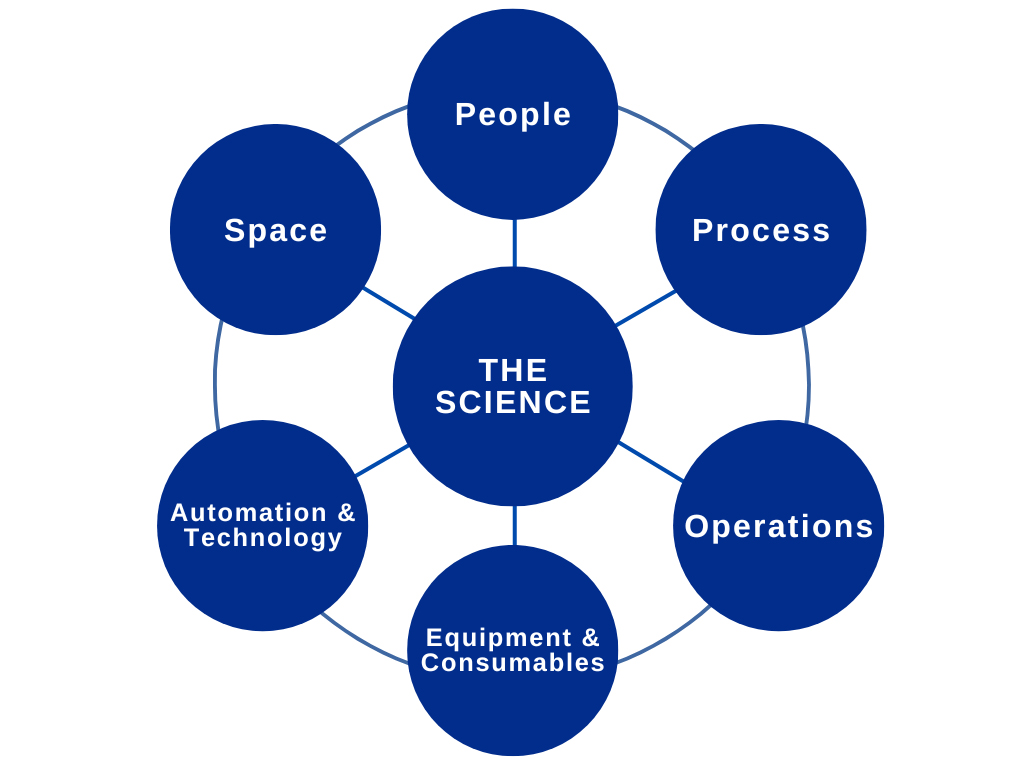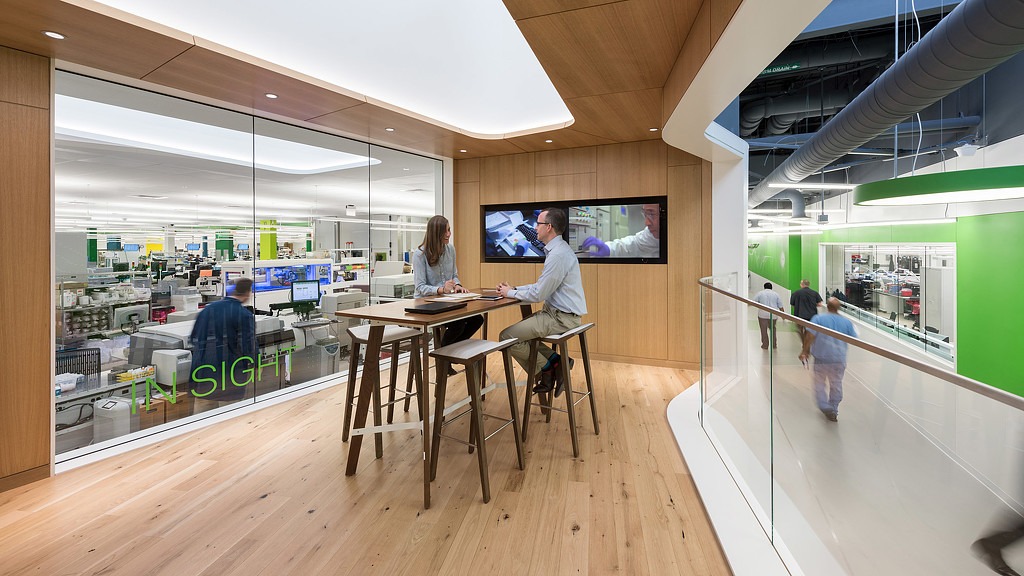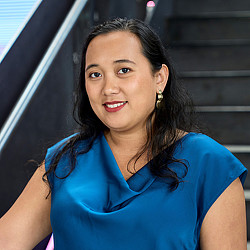Using an “All-Spokes” Approach to Optimize Lab Space
April 16, 2024 | By Altair Galgana-Wood and Darshan Shah
As organizations navigate the ups and downs of the economy and its effects on funding availability, it is important to evaluate resource allocations with a keen eye. When it comes to space, real estate decisions should start with “Do I actually need more space? Are we using our existing space to its best capacity?”
Unlike traditional office space, labs have many more variables to consider when it comes to optimization. It is not just a space question but rather the nexus of space, people, process, operations, equipment, and technology.

Rather than focusing solely on a single “spoke” (space, people, process, etc.), each variable must be considered in the context of the others to understand the complete picture. A robust understanding of the science requires a balance of quantitative data and qualitative input from the end users. Leveraging existing expertise within the organization provides some initial insights; however, digging deeper and considering all spokes of the wheel will help organizations arrive at a stronger long-term solution.
To better understand how life sciences and pharmaceutical companies can optimize for an “all-spokes” approach, Gensler surveyed a number of clients in the industry to learn more about the work habits of their scientists and how their lab spaces are organized. The resulting case studies revealed several common challenges that could be overcome by embracing a more holistic approach.
Challenge #1: “I’ve wasted too much time trying to figure this out.”
A detailed analysis of how scientists spent their time revealed that 23% of every week went to administrative or maintenance tasks. Gensler uncovered that most scientists did not know who to go to for guidance or what the subsequent steps in the process were. Scientists regularly spent time trying to troubleshoot equipment, figure out who to talk to, or determine how best to communicate with the next person in the process. As one of the interviewed scientists put it, “I know someone’s figured this out, but I don’t know who or how to leverage their genius.” So, what factors need to be addressed that would allow us to “give time back” to the scientists?
One of the most common challenges is a tendency for tribal knowledge with limited cross-group knowledge sharing. For one mid-size R&D group, shadowing the scientists revealed that teams relied on tribal knowledge, where they knew each teammate’s expertise. For example, one of the engaged teams identified their go-to person for writing automation scripts on new machines. At the same time on another team, a piece of equipment went unused because the only expert in the ‘tribe’ transitioned to a different role.
The study also revealed that particular experts only existed within each tribe, and there were very few moments or places for these individuals to share their expertise. To create pathways for formal and informal sharing of knowledge, the organization implemented structured forums, such as seminars and trainings, and built engaging collaboration spaces, such as innovation hubs and kanban stations, for informal sharing.

At a maturing life science startup, the study revealed overlapping roles and tasks across the organization. The lack of fluidity between teams resulted in redundant equipment, expertise, and processes. Teams reactively purchased equipment and hired or trained experts to address a specific scientific need, independent of what resources may be available in other parts of the organization. For example, multiple teams had a microscopy function, with their own equipment and people. As part of the proposed solution, the organization built a series of “core services” that supported multiple teams’ analytical needs. The newly consolidated microscopy team, with a dedicated core lab space, provided a more diverse set of analytic offerings, housed a team of dedicated microscopy experts, and improved overall spatial efficiency — doing more with less.
Similarly, instead of building separate, high-cost tissue culture spaces for each group, the organization created a tissue culture (TC) core. The new TC core offered improved cleanliness, reduced contamination risks, and allowed for the implementation of sophisticated automation protocols. The larger, more robust core lab enabled experts to work side-by-side with different teams, serving as a connector across the organization. This cross-pollination allowed scientists to know who to go to for help and created opportunities for unique cross-team approaches to their most complex problems. By establishing a brain trust of experts, scientists felt comfortable relying on the TC core team to run more thorough analyses and collect higher-quality data. Having consistent, reliable data also established a strong foundation for the organization’s growth and supported alignment with federal regulations.
It’s worth noting that moving to a ‘core services’ approach was a major culture shift for the organization. Many of the scientists had come from academia with a “Principal Investigator” mindset rather than a collective mindset. Beyond assisting with the design, Gensler supported the change management to the new model and crafted communications to highlight the benefits of this new, optimized approach.
Challenge #2: “Oh, you’ll need to talk to someone else about that.”
It’s surprising how scientists often do not know the broader context of their work. Although they are experts on their part of the process, they are rarely cognizant of anything further than the step before and the step after. Executives and leadership know the general charge of each group, but our studies show that very few have a complete grasp on the full extent of the process.
For an established R&D group within a pharma company, Gensler partnered with the scientists to craft a detailed map of the process, surfacing the relationships between groups and critical hand-off points. The resultant diagram was the first time anyone had seen the process in its entirety. Workshopping revealed many “ah-hah” or “oh, you do that?” moments, highlighting the lack of comprehensive understanding. The process mapping allowed us to identify bottlenecks and unnecessary redundancies. We estimated an approximate 15% improvement in efficiency through a series of solutions. Solutions included: a common electronic notebook system that became a single source of truth through the process, digital cold storage management to know where things were stored and when, and the use of consistent consumables at each step to minimize the constant changing from one vessel to another. In addition, we found that by understanding the end-to-end process, scientists felt better connected to the organization’s mission and goals, supporting longer scientist tenures, improved internal mobility, and expanded collective buy-in.
At an established pharma company, lab user focus groups identified the need for consistent lab operations across departments. Each department was operating independently, almost like a separate company within the organization. For example, one department was leveraging an external vendor for media prep, while another had each scientist preparing their own. Additionally, each group handled consumables procurement independently. As a result, teams were bulk ordering consumables (pipettes, slides, etc.) to capture the bulk discount, then requesting additional space to store more than a year’s worth of supplies.
As part of the findings, 14% of lab benches were occupied by consumable storage. Through a guided cleanup of the labs, 24% of consumables, still in their original packaging, were found to be past their expiration and disposed of. By implementing a central procurement process, teams could take advantage of bulk order pricing, with multiple groups sharing a single order. Spatially, all consumables were consolidated to a single location, where each scientist could pick up only what they needed. The consumables stockroom was outfitted with a barcode inventory system that allowed scientists to quickly scan what they needed, and the department was billed accordingly. Consolidation to a central stockroom allowed consumables-occupied benches to be freed up for scientists as revenue-producing workstations.
When optimizing for technical spaces, it is important to take an “all-spokes” approach and consider the interrelated aspects of people, process, operations, equipment, technology, and space. As demonstrated through these examples, a holistic approach increases the scale of impact and the likelihood of success of any real estate decisions. An experienced strategy-minded team can align stakeholders and untangle the most complex real estate challenges. Whether addressing a small lab utilization problem or approaching large-scale portfolio optimization, starting with a comprehensive understanding of the science ensures a sustainable and effective solution.
For media inquiries, email .

